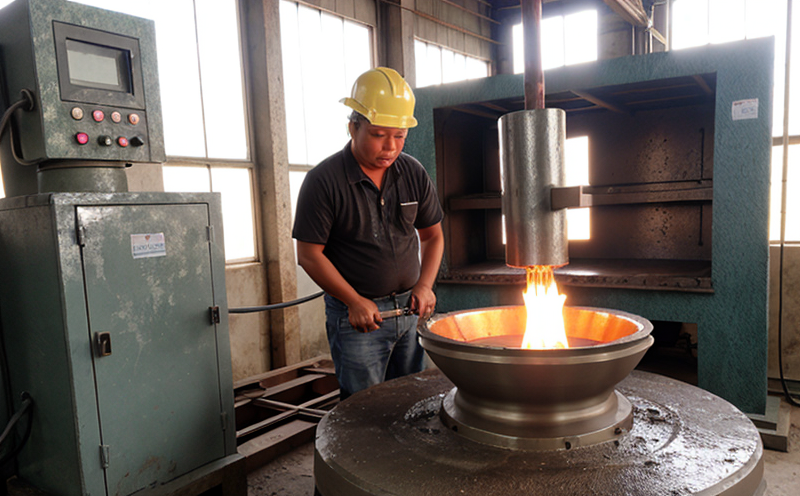ASTM A802 Casting Surface Visual Inspection Testing
The ASTM A802 standard provides a comprehensive framework for performing visual inspection of castings to ensure compliance with specified requirements. This service is essential in the industrial manufacturing and processing sector where quality control and assurance are paramount.
The casting surface visual inspection testing focuses on identifying defects, such as cracks, porosity, and slag inclusions that can compromise the integrity of the casting. This process plays a critical role in ensuring that castings meet the required specifications for strength, durability, and performance in various applications.
Quality managers and compliance officers rely heavily on this testing to ensure that their products adhere to industry standards. R&D engineers use ASTM A802 testing as a tool to refine casting processes and materials. Similarly, procurement teams benefit from these tests by ensuring the quality of raw materials used in manufacturing.
The testing process begins with careful preparation of the castings. This involves cleaning the surface to remove any dirt or debris that could interfere with the inspection. The cleaned castings are then carefully examined under controlled lighting conditions using a variety of visual aids such as magnifying glasses and digital cameras. The visual examination is conducted by trained personnel who have expertise in interpreting the results accurately.
Once the initial surface checks are completed, further testing may be required depending on the nature of defects observed. This could include more detailed inspections or even destructive testing to fully assess the integrity of the casting. The results of these tests are meticulously documented and reported back to relevant stakeholders for review and action.
The ASTM A802 standard ensures that all visual inspections are conducted in a consistent manner, thereby providing reliable data that can be used to make informed decisions about product quality and process improvements. This consistency is achieved through adherence to strict procedures outlined in the standard, which cover everything from specimen preparation to final reporting.
By leveraging ASTM A802 casting surface visual inspection testing, manufacturers can significantly enhance their ability to produce high-quality castings that meet both internal and external requirements. The service offered here ensures that every aspect of the casting process is scrutinized under a rigorous set of guidelines, leading to more robust products and greater customer satisfaction.
For those looking to implement ASTM A802 testing within their organization, our team of experts can provide tailored solutions that align with specific needs. Whether you're seeking assistance in setting up an internal inspection program or need ongoing support for existing processes, we have the expertise to help you achieve your goals. Contact us today to learn more about how we can assist you.
Applied Standards
- ASTM A802: Standard Practice for Visual Inspection of Castings
The ASTM A802 standard is widely recognized as the gold standard in visual inspection practices for castings. It provides detailed instructions on how to conduct thorough inspections, ensuring that all potential defects are identified and documented accurately.
By following these guidelines, manufacturers can ensure that their products consistently meet or exceed industry expectations. The standard also helps to promote best practices across different sectors, fostering a culture of continuous improvement in casting technology.
Scope and Methodology
| Step | Description |
|---|---|
| Preparation | Clean the castings thoroughly before inspection using appropriate methods. |
| Inspection | Examine the surface under controlled lighting conditions with various visual aids. |
| Data Collection | Meticulously document all observations and findings during the inspection. |
| Reporting | Compile comprehensive reports summarizing the results of the inspections. |
The scope of ASTM A802 testing encompasses a wide range of casting types, including steel, iron, and non-ferrous metals. The methodology involves detailed examination techniques that are designed to detect even minor defects on the surface of castings. These examinations help in identifying issues early on, allowing for timely corrective actions before they become more serious problems.
The step-by-step approach ensures that no detail is overlooked during the inspection process. From initial preparation through final reporting, each stage contributes to building a robust record of the casting’s condition. This comprehensive documentation serves as valuable reference material for future quality audits and improvements.
Quality and Reliability Assurance
- Consistent application of ASTM A802 standards across all inspections.
- Use of advanced technology like high-resolution cameras and magnifying lenses to enhance accuracy.
- Regular training for inspectors to maintain proficiency in identifying various defects.
- Implementation of robust quality control measures post-inspection.
To ensure the highest levels of quality and reliability, our team adheres strictly to ASTM A802 standards throughout every inspection. Advanced technologies such as high-resolution cameras and magnifying lenses are employed to capture detailed images which aid in accurate defect identification. Regular training sessions for inspectors guarantee that they remain up-to-date with current best practices.
After completing each inspection, robust quality control measures come into play ensuring that any identified issues are addressed promptly. This commitment to excellence helps maintain a high standard of reliability across all services provided by our laboratory.





